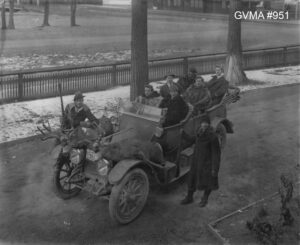Vernon is described as “A Sportsman’s Paradise” in a promotional booklet from 1891. “Big game abounds in caribou, white and black-tailed deer, and on the higher mountains big horn sheep and goats,” the brochure continues.
“More remote are to be found great black, cinnamon and grizzly bears. There are a few grey wolves, lynx, coyote and the king cat of the Rockies, the American panther.”

This advertisement was incredible successfully and over the next few years hunters came from far and wide to take advantage of the Okanagan’s bounty.
At this point, there was little in the way of game law enforcement, and no game wardens, and the citizens of Vernon wrote many letters of complaint against the hunting parties, most of whom were visiting from the South.
In September 1892, a hunting party from eastern Canadian killed 180 sage grouse at the Head of the Lake, destined for the Vancouver market.
A party of 20 Americans arrived in a private rail car to hunt big game that same year. They took only the heads and left the meat to rot.
In 1904, one family shot 92 blue grouse in a single day.
This was a very different kind of hunting than the Syilx people of Okanagan Nation had practiced as a traditional way of life, livelihood and culture for thousands of years.
Before non-Indigenous contact, the Syilx had been a hunter-gatherer culture who used every part of the animals they hunted as meat for food, but also fur for clothing and warmth, hide for clothing and structures, bones for tools and implements. Sinew was used as thread in sewing.
No part of the animal was wasted, and animals were hunted sustainably, for thousands of years, without negative impact on their populations.
In a 1912 Vernon News special holiday edition, pioneer Mr. Leckie-Ewing noted that big game in the Okanagan had decreased significantly in number or their haunts had moved further away.
Lake trout populations, once an important food source for the Syilx People, had all but disappeared from Okanagan Lake. Blue grouse and other fowl were still around, but their numbers had “sadly diminished when compared with … some ten or twelve years prior.” In fact, sage grouse became extinct in the Okanagan in 1918.
By the 1950s, excessive hunting also meant that mountain caribou had disappeared from the Okanagan.
The Syilx people still pass on sustainable hunting practices and knowledge within their communities, and some of this traditional knowledge has been used to inform best management practices for wildlife conservation. First Nations groups in BC and in Alberta are consulting on caribou recovery projects across the region.
The biggest threat to mountain caribou populations in BC and Alberta, and south of the border, is no longer sport hunting, but rather other forms of human impacts, most notably transportation corridors, infrastructure for resource extraction, such as forestry, mining, oil and gas exploration, and recreational vehicle use areas all encroaching on their habitat.
These same things allow caribou predators, such as wolves, easier access to caribou habitat to the detriment of the caribou population.
Today, we are fortunate to have stricter regulations in place around hunting and fishing, and a better understand of how humans can significantly effect wildlife populations. However, before these measures were put in place, visiting hunters negatively impacted Okanagan wildlife populations.
To help preserve our local fauna populations, trophy hunting and other wasteful practices should be discouraged. Residents should also remove or limit attractants like garbage and fallen fruit to discourage animals like bears from becoming urban visitors. Do not feed or try to tame wild animals, but keep them and yourself safe by maintaining an appropriate distance.
Perhaps most importantly, if there are regulations in place to attempt to keep wild animal habitat preserved, respect these regulations and ride recreational vehicles, hunt, and recreate in other designated areas.
Gwyn Evans

